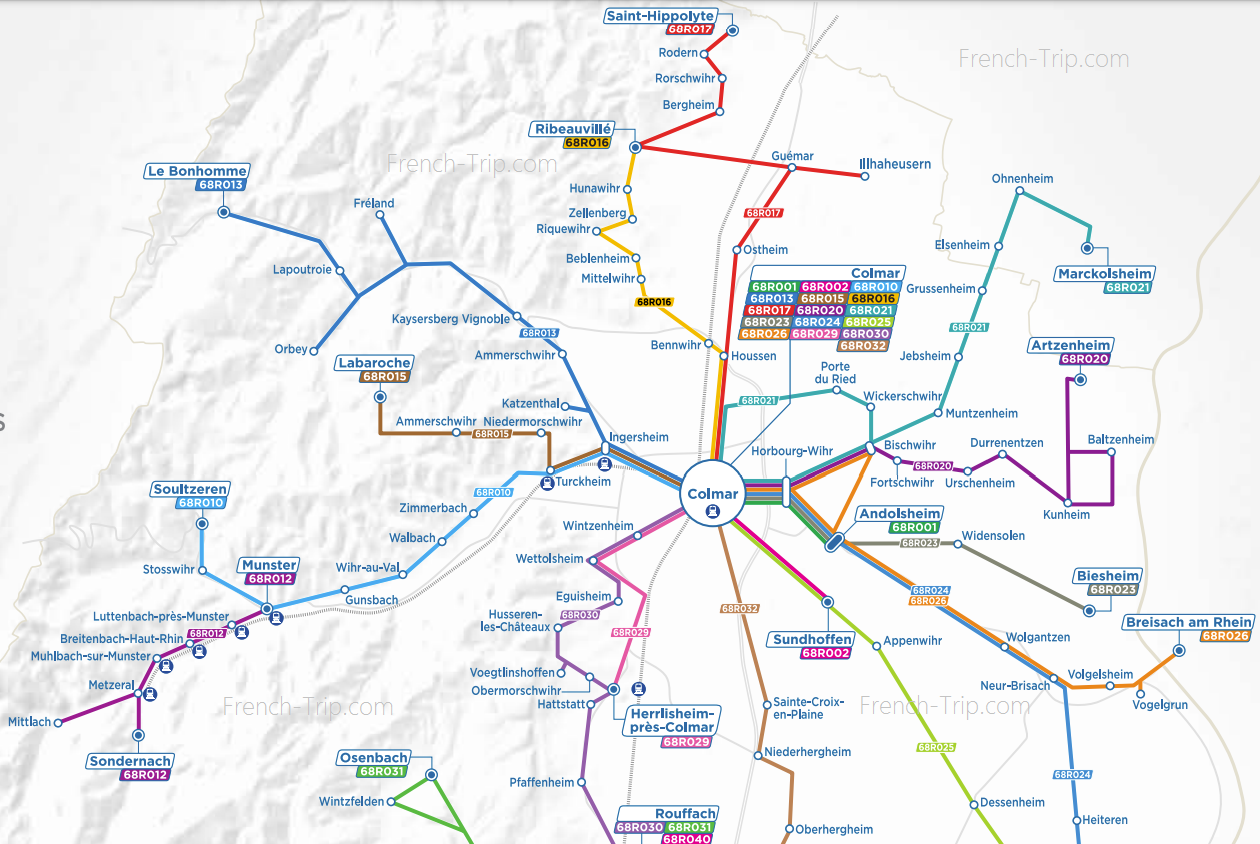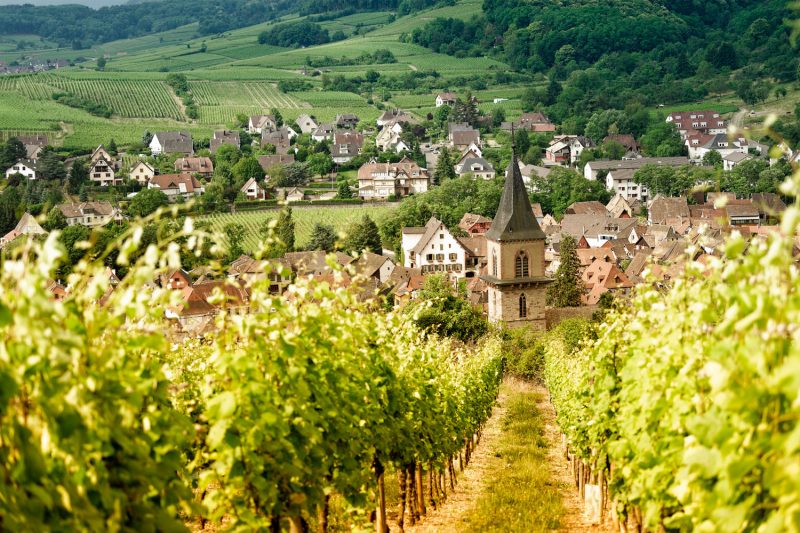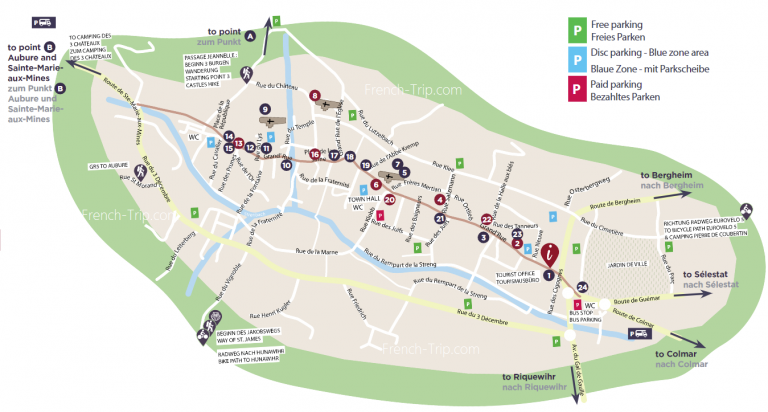Ribeauvillé travel guide
Nestled between vineyards and mountains, Ribeauvillé (departament Haut-Rhein) is a charming half-timbered town with 5,000 residents, making it one of the oldest towns in Alsace. Overlooking the town are the majestic ruins of three castles (more about them below) of the Lords of Ribeaupierre, from whom the town gets its current name.
Ribeauvillé is located 15 km north of Colmar. There is a direct bus from Colmar along the Alsace Wine Route, passing through the most beautiful surrounding villages, such as Riquewihr and Hunawihr.
Ribeauvillé travel guide
The main street is Grand-Rue, and the picturesque neighboring lanes, lined with houses from the 15th to the 18th century (in summer, they are adorned with flowers), branch off from the central square, which is decorated with a Renaissance-style fountain. Here, you can visit the town hall with its collection of silver goblets, the 13th-century Butchers’ Tower, the former grain exchange, and more.
From May to October, free tours of the old town of Ribeauvillé are organized daily (except Mondays and Saturdays), and there is also a tourist train.
The vineyards surrounding Ribeauvillé have existed since the Middle Ages. You can visit wine cellars and participate in tastings. Notably, there are three Grands Crus: Geisberg, Kirchberg de Ribeauvillé, and Osterberg.
In spring, there is a spring market, and in early May, the Kougelhopf festival (according to local chefs, Ribeauvillé is the capital of Kougelhopf, the airy almond Alsatian cake), in July, a wine festival, on the first Sunday of September, a violin festival, in October, an ancient music festival, and a medieval Christmas market awaits you in December.
The minstrels festival or “Pfifferdaj” is a fine legacy of the historic past of Ribeauvillé. As the oldest event of Alsace, it has kept its traditions, costumes, colours and the reputation acquired since the 14th century by hundreds of musicians and troubadours gathered in Ribeauvillé.
Worth to visit?
Compared to other picturesque towns in Alsace, Ribeauvillé offers both their charm and larger size, making it lively even on Sundays. You can easily have a meal at a restaurant and stroll through the streets (primarily one central street) of the town. Unlike the smaller villages, Ribeauvillé features several very beautiful squares, each more picturesque than the last, and an impressive church. Though Ribeauvillé is not recognized as “One of the Most Beautiful Villages in France” (Les Plus Beaux Villages de France), perhaps solely because of its size, it is certainly deserving of the title more than Hunawihr, in my subjective opinion.
Is it worth a visit? Absolutely! Ribeauvillé is as beautiful as the most stunning places in Alsace.
Wine Tasting:
In Ribeauvillé, there are several wineries where you can taste wine and Crémant d’Alsace for free. The largest selection of wine and the best tasting room can be found at Cave de Ribeauvillé — a large building on the ring road with ample parking, at the entrance to Ribeauvillé.
Wheather in Ribeauvillé

Get in
There are direct buses to Ribeauvillé from Colmar (2 buses), from Riquewihr, from Selestat and from Saint-Hippolyte. There is no railway station in the city. In addition in high season you can use a tourist panoramic bus route.
More: How to get to Ribeauvillé

History of Ribeauville
The first name of the city appears in the 8th century under the reign of Pepin the Short: Radbaldovillare. That name is believed to be a contraction of the name of the owner of an estate, Ratpold, and villae, a country house with farm buildings and a dwelling.
In the year 1084, Emperor Henry IV of Franconia donated a piece of land called “Rapoldestein” to the Bishop of Basel. He transferred it one of his vassals, Eguenolf of Urslingen who married Emma, the last descendant of the Ribeaupierre family.
In the Middle Ages, the destiny of the town was closely linked to that of the seigniorial family of the Ribeaupierres. In the 13th century, Ribeauvillé became a real town with an old centre and four new districts: two upper towns and two lower towns.
The town was fortified and four gates were built. At the end of the Thirty Years War, it came under the French crown.
Ribeauvillé is also known for wine-growing, which has had an impact on the town. There are three Grand Crus within its limits: Geisberg, mainly growing Riesling, Kirchberg of Ribeauvillé and Osterberg.
What to see in Ribeauvillé
Most of Ribeauvillé’s attractions are located along the main street, Grand Rue. Slightly off from it, two historic churches are visible. The Ribeauvillé castles can be seen from the city center and are within walking distance; exploring the ruins provides breathtaking panoramic views of the surrounding mountains.
On Grand Rue, the House of Minstrels is particularly notable. It now houses a restaurant.
Winding alleys lead up to the upper part of the town, where you’ll find quaint, tiled houses of craftsmen and winemakers.
Beyond them, you can see the facades of buildings and the Gothic parish church of St. Gregory the Great. A well-trodden path leads from this part of town directly to the vineyards.

Self-guide walking tour of Ribeauvillé
The Ribeauville walking tour will take you throughout the city as quickly and conveniently as possible, pointing out the most interesting buildings. You should plan about a couple of hours for the route (this does not include the climb to the castle ruins, but only a walk around the city itself).

Castles of Ribeauvillé
Ribeauvillé is best known in Alsace for its Three Castles, located on the same mountain and overlooking the city.
Castle Saint Ulrich — the residence of the powerful feudal Ribepierres until the beginning of the 16th century — is one of the most prestigious forts in Alsace. With the nearby castles of Haut-Ribeaupierre (12th century) and Girsberg (13th century), it forms one of the main feudal ensembles and the most historically valuable buildings in Alsace.
- Chateau du Haut-Ribeaupierre
- Chateau du Girsberg
- Chateau de Saint-Ulrich
- Château du Ribeauvillé or château Bas des Ribeaupierre
You can walk up to the castles — there is a walking trail leading to them. The road to the main castle — St Ulrich — will take about 40 minutes one way. You can walk with children, but the road is not entirely easy, with rocky stones in places, so you need comfortable shoes.
Eat in Ribeauvillé
In Ribeauvillé, as in other nearby towns, you can enjoy delightful and hearty Alsatian cuisine. It’s worth noting that, overall, prices in Ribeauvillé are slightly more moderate compared to the most tourist-heavy towns, such as Riquewihr, though they still don’t differ much on average.
One of the most pleasant (and relatively affordable) places to dine is at a restaurant on the central square. There, you’ll find the Brasserie de la Poste with a charming terrace. Although it is quite touristy and has an average rating, I would like to highlight it for its wonderful views, extensive selection of Tarte Flambée (including sweet versions), availability of potato gratin with Münster cheese (which is rare to find nowadays), and reasonably priced menu (cheaper than many neighboring establishments).
However, along the main street, you will find many other options. Choose based on the menu offerings!
- Restaurants in Ribeauvillé
- Alsatian Cuisine
- Alsatian Wines
Shopping in Ribeauvillé
Shopping in Ribeauvillé is concentrated along the main street: here you will find many souvenir shops and shops with local products, be it groceries or handicrafts. There are even several shops with clothes and accessories.
Les Mille et Une Nappes (59 Grand’Rue, 68150 Ribeauvillé) is a lovely little boutique with a very picturesque facade and beautiful home textiles. This is not the first time we have left here with tablecloths made of linen, cotton and with a special coating: very beautiful colors in Italian and French styles and quite reasonable prices (there are also discounts). Nice polite seller who can speak English.
Souvenirs from Ribeauvillé
- Souvenirs from Alsace
- Stuffed Toys
- Housewares painted in an Alsatian theme
- Alsatian wine glasses
- Ceramics with traditional Alsatian painting
- All sorts of toys and souvenirs with an Alsatian theme
- Kitchen towels, aprons and potholders with a pattern about Ribeauville and Alsace
- Kugelhopf cupcakes
- Craft beer with frivolous labels
- Alsace wines from tasting rooms
- Alsatian sausages (can be a set of 5 different types)
- Alsatian cheeses (look for vacuum-packed ones, otherwise everything will smell)
- Terrines and foie gras
- Tablecloths from boutique above
Around Ribeauville
Travel distance and time by car:
- Alsace Wine Route
- Hunawihr 2, 4 km, 5 minutes (Plus Beaux Villages de France)
- Riquewihr 4 km, 7 min (Plus Beaux Villages de France)
- Bergheim 7 km, 14 min. (ville fleurie 4*)
- Kaysersberg 12 km, 16 min
- Turckheim 14.5 km
- Château du Haut-Koenigsbourg 16 km, 23 min
- Colmar 17 km, 24 min
- Sélestat 19 km, 23 min
- Eguisheim 20 km, 24 min (Plus Beaux Villages de France)
Ribeauvillé on the map:
Archives
Calendar
| M | T | W | T | F | S | S |
|---|---|---|---|---|---|---|
| 1 | 2 | 3 | 4 | 5 | 6 | 7 |
| 8 | 9 | 10 | 11 | 12 | 13 | 14 |
| 15 | 16 | 17 | 18 | 19 | 20 | 21 |
| 22 | 23 | 24 | 25 | 26 | 27 | 28 |
| 29 | 30 | 31 | ||||